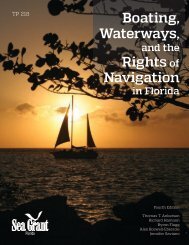Adopt-A-Wetland
XQDrg
XQDrg
Create successful ePaper yourself
Turn your PDF publications into a flip-book with our unique Google optimized e-Paper software.
If your wetland shows signs of die-off be sure to contact your local <strong>Adopt</strong>-A-<strong>Wetland</strong> coordinator so that<br />
further testing at the site can be done and the appropriate agencies notified.<br />
Pollution<br />
Pollution can be a main contributor to wetland die-off. Pollution is any substance introduced to the<br />
environment that has harmful effects. Pollutants enter estuaries by different sources and are called point<br />
source pollution and nonpoint source pollution. Point source pollution comes from a specific source that<br />
can be identified such as a pipe, channel, or other obvious discharge point from a single location. Examples<br />
of point source pollution are industrial discharge or wastewater from a treatment plant. Currently, the 1972<br />
Clean Water Act regulates point source pollution. Nonpoint source pollution is much harder to regulate<br />
because it comes from a variety of discharge areas rather than a single identifiable source. Examples of<br />
nonpoint sources include storm water runoff from urban areas, marinas, agriculture, forestry, construction,<br />
leaky septic tanks, vehicles, and lawns. Leaky septic tanks and pet waste that is not picked up pollute<br />
waterways with harmful bacteria and excess nutrients that pose major health concerns. Sediment in runoff<br />
from construction sites, agricultural activities, forestry operations, and dredging can carry harmful<br />
environmental pollutants and increase turbidity. The sediments transported by the runoff can cover and kill<br />
critical benthic habitats and also carry dangerous heavy metals and other pollutants with them. If you<br />
identify a problem while monitoring, go to your contact list and choose an appropriate person/agency to<br />
call.<br />
Marine Debris<br />
The National Oceanic and Atmospheric Administration defines marine debris as "any persistent solid<br />
material that is manufactured or processed and directly or indirectly, intentionally, or unintentionally,<br />
disposed of or abandoned into the marine environment or the Great Lakes." Marine debris poses a potential<br />
threat to human health, endangers wildlife, and degrades habitat.<br />
83 DRAFT AUGUST 2015



